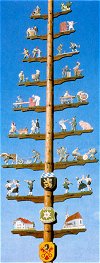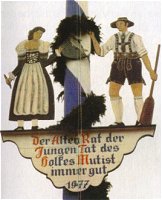MAY DAY
In the German-speaking countries the first day of May is a national
holiday, similar to Labor Day in the States. It is the International
Workers' Day - Tag der Arbeit, when workers gather for rallies and speeches,
to collectively express their unity. However, it is more than that. To
this day a variety of May festivals abounds.
May was a joyous time in the ancient calendar. The fairies (pagan
spirits), the rulers of May, would help Earth to clad herself once more
in green. In farming areas, spring, summer and the beginning of autumn
were filled with work--interrupted only by the midsummer celebrations.
May Day was very much anticipated, and weather rules abound: "Mairegen
bringt Segen" (Rain in May brings blessings). It was the day when in
some areas the cattle were taken out to pasture for the first time.
 Many customs are connected to this day and symbols abound. Maiglöckchen
(Maybells) are in bloom and in the stores children can purchase chocolate
Maikäfer (May beetles). Houses and dance halls are decked with young green
and flowers, and songs celebrate this joyous occasion. May is the month
most sung about by poets and song-writers. A part of the celebrations are
ceremonial plantings of seedlings or young trees. The Maypole is put up
and there are dances around it. There may be a May play or a May Queen
contest. In some areas, a whole village may gather around a Maypole.
Everybody holds hands, dances, drinks, and is happy not to have to be
at work for a day. There may be a merry procession to Maypole or dance
hall, where the May Queen ceremonially declares winter defeated and opens
the dance.
Many customs are connected to this day and symbols abound. Maiglöckchen
(Maybells) are in bloom and in the stores children can purchase chocolate
Maikäfer (May beetles). Houses and dance halls are decked with young green
and flowers, and songs celebrate this joyous occasion. May is the month
most sung about by poets and song-writers. A part of the celebrations are
ceremonial plantings of seedlings or young trees. The Maypole is put up
and there are dances around it. There may be a May play or a May Queen
contest. In some areas, a whole village may gather around a Maypole.
Everybody holds hands, dances, drinks, and is happy not to have to be
at work for a day. There may be a merry procession to Maypole or dance
hall, where the May Queen ceremonially declares winter defeated and opens
the dance.
The Maypole and the dance around it is a major symbol of spring's
reawakening of fruitfulness. May was known as the "Wonnemond," the month
of lovers where a young man's fancy would turn to love. In May the largest
number of weddings take place. Over time the Maibaum (May-tree) lost its
original meaning, that of celebrating a wedding. In days gone by, young
unmarried men of the village would organize and sponsor parties, dances
and celebrations, to get the unmarried maidens of the village into the
spirit of May. If then a wedding would take place, a tree decorated with
colorful streamers and ribbons would be placed in front of the bride's
house.
 The May pole may be officially erected in the market place, in front
of city hall or some other prominent spot in town. Often colorful carved
shingles or signs decorate the Maypole and indicate the town's various
trades and professions. It may be up during the entire month of May, or
even longer. The Maypole in Munich, located on the Viktualienmarkt not
far from the Marienplatz, has become a permanent fixture. It stays up
all year. The Maytree would be erected on top of the Maypole.
The May pole may be officially erected in the market place, in front
of city hall or some other prominent spot in town. Often colorful carved
shingles or signs decorate the Maypole and indicate the town's various
trades and professions. It may be up during the entire month of May, or
even longer. The Maypole in Munich, located on the Viktualienmarkt not
far from the Marienplatz, has become a permanent fixture. It stays up
all year. The Maytree would be erected on top of the Maypole.
While Mayfests abound in the German-American community, there are
only a few Maypole's in the U.S. One can be seen near the Courthouse in
Jasper, Indiana. Another custom that made it to the U.S, is the dance
around the Maypole. The Fledermäuschen Tanzgruppe of the German-American
Klub in Indianapolis performs a folkdance version of it at their annual
Maifest.
The traditional Maypole dance starts with long ribbons attached high
up on the pole. Each dancer holds the end of a ribbon. The circle of
dancers begins far out from the pole, so the ribbons are kept fairly
taut. There should be an even number of dancers, facing alternatively
clockwise and counterclockwise. All dancers move in the direction they
are facing, passing right shoulders with the next, and so on around to
braid the ribbons over-and-under around the pole. Those passing on the
inside will have to duck, those passing on the outside raise their ribbons
to slide over.
In Bavaria May 1 is an especially important day for it is "Unsere
Liebe Frau als Schutzfrau Bayerns" (Our Dear Lady as Patron Saint of
Bavaria) also called the "Fest Patrona Bavariae". Festivals there have
a special Bavarian flavor.
In Bavarian villages, it has been the custom for centuries to cut
a tall and straight tree, a day or two before May 1, place it in the
middle of the village and decorate it with a wreath of spring flowers
and colorful ribbons. One of the traditions is to attempt to steal the
Maypole of the neighboring village on the night before, and to hold it
for ransom, usually a couple kegs of beer. At the same time villagers
had to make sure that their maypole was not stolen by their neighbors.
Another Bavarian tradition is the Maibaumkraxeln (Maypole climbing)
contest. In many parts of Bavaria guys battle to see who can climb up
the shaven and polished tree trunk the fastest, a task made even tougher
by soaping down the Maypole, so that climbers only have a good shot if
they smear ashes, tree sap or pitch on their hands. The goal is to win
the Brezeln und Würste (pretzels and sausages) that hang atop the pole,
and to impress the girls down in the crowd. Beginners climb carefully,
gradually and in spurts. Veterans will grab a hold of the tree between
hands and feet and climb right up. These are trees, 15 m (46 ft.) high,
without branches, no bark, and slick as a grease pan!
Maiwein (May Wine) is a German drink, dedicated to springtime and
flavored with fresh Waldmeister (sweet woodruff). Maiwein, a white wine,
imported from Germany, can be found in stores. Waldmeister is an old-world
herb, a small plant with white blossoms. In Germany it grows in the forests.
However, the variety which grows wild here is not usable for flavoring.
This decorative plant may be grown in a shady corner of an herb garden.
It should be used for flavoring only in May when the new leaves are tender.
Cut up and soaked in the wine it will produce the distinctive May Wine
taste.
You can make your own Maiwein by using a good white wine and
flavoring it with woodruff. For a Maibowle (May punch) you can add
carbonated water or champagne. The following recipe is from "Joy of
Cooking" by Rombauer and Becker
Place in a bowl:
12 sprigs young waldmeister
1 1/4 cup powdered sugar
1 bottle Moselle or other dry white wine
(1 cup brandy)
Cover the mixture for 30 minutes, no longer.
Remove the waldmeister. Stir contents of bowl thoroughly
and pour over a block of ice in a punch bowl. Add:
3 bottles Moselle
1 quart carbonated water or champagne
Thinly sliced oranges, sticks of pineapple and, most
appropriately, sprigs of waldmeister, may be used
to decorate the "Maitrank."
AN DEN MAI, melody W. A. Mozart
1. Komm lieber Mai und mache
Die Bäume wieder grün
Und lass uns an dem Bache
Die kleinen Veilchen blühn.
Wie möchten wir so gerne
Ein Blümchen wieder sehn!
Ach lieber Mai wie gerne
Einmal spazieren gehn.
2. Zwar Wintertage haben
Wohl auch der Freuden viel;
Man kann im Schnee eins traben
Und treibt manch Abendspiel,
Baut Häuserchen von Karten;
Spielt Blinde-Kuh und Pfand;
Auch gibt's wohl Schlittenfahrten
Auf's liebe freie Land.
3. Doch wenn die Vöglein singen
Und wir dann froh und flink
Auf grünem Rasen springen,
Das ist ein ander Ding!
Drum komm und bring vor allem
Uns viele Rosen mit,
Bring auch viel Nachtigallen
Und schöne Kuckucks mit!
C. A. Overbeck
From the Engelbert Humperdinck Edition of SANG UND KLANG FÜRS
KINDERHERZ; Berlin: Neufeld & Henius (1911)
Ruth Reichmann
Max Kade German-American Center
Indiana Univ.-Purdue Univ. Indianapolis
FURTHER RESOURCES
May Day Tradition of dressing up in Bohemia.
Maienwetter and Bauernregeln.
Further links can be found on the Walpurgis page.
Conduct internet searches for further resources.
Return to Customs Page
 Many customs are connected to this day and symbols abound. Maiglöckchen
(Maybells) are in bloom and in the stores children can purchase chocolate
Maikäfer (May beetles). Houses and dance halls are decked with young green
and flowers, and songs celebrate this joyous occasion. May is the month
most sung about by poets and song-writers. A part of the celebrations are
ceremonial plantings of seedlings or young trees. The Maypole is put up
and there are dances around it. There may be a May play or a May Queen
contest. In some areas, a whole village may gather around a Maypole.
Everybody holds hands, dances, drinks, and is happy not to have to be
at work for a day. There may be a merry procession to Maypole or dance
hall, where the May Queen ceremonially declares winter defeated and opens
the dance.
Many customs are connected to this day and symbols abound. Maiglöckchen
(Maybells) are in bloom and in the stores children can purchase chocolate
Maikäfer (May beetles). Houses and dance halls are decked with young green
and flowers, and songs celebrate this joyous occasion. May is the month
most sung about by poets and song-writers. A part of the celebrations are
ceremonial plantings of seedlings or young trees. The Maypole is put up
and there are dances around it. There may be a May play or a May Queen
contest. In some areas, a whole village may gather around a Maypole.
Everybody holds hands, dances, drinks, and is happy not to have to be
at work for a day. There may be a merry procession to Maypole or dance
hall, where the May Queen ceremonially declares winter defeated and opens
the dance.  The May pole may be officially erected in the market place, in front
of city hall or some other prominent spot in town. Often colorful carved
shingles or signs decorate the Maypole and indicate the town's various
trades and professions. It may be up during the entire month of May, or
even longer. The Maypole in Munich, located on the Viktualienmarkt not
far from the Marienplatz, has become a permanent fixture. It stays up
all year. The Maytree would be erected on top of the Maypole.
The May pole may be officially erected in the market place, in front
of city hall or some other prominent spot in town. Often colorful carved
shingles or signs decorate the Maypole and indicate the town's various
trades and professions. It may be up during the entire month of May, or
even longer. The Maypole in Munich, located on the Viktualienmarkt not
far from the Marienplatz, has become a permanent fixture. It stays up
all year. The Maytree would be erected on top of the Maypole.